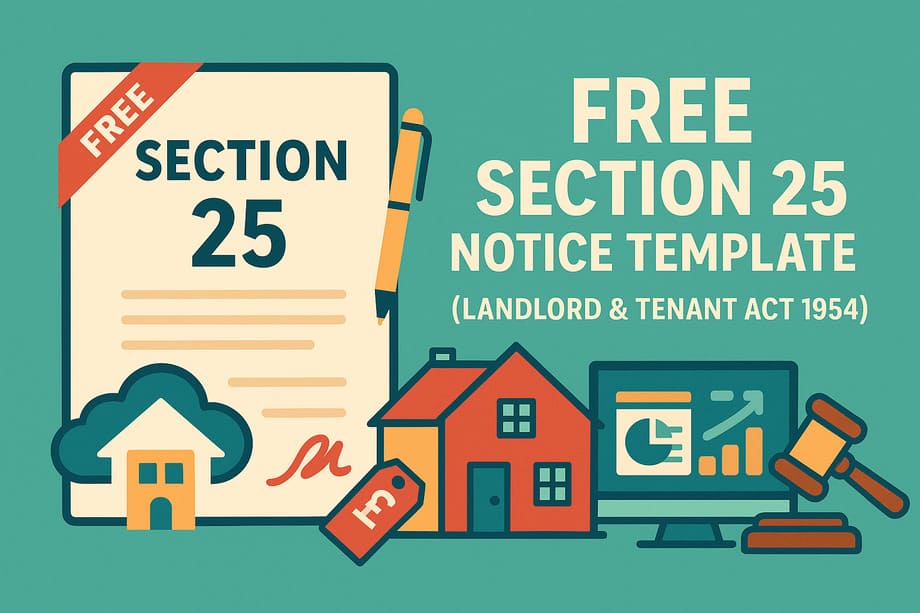Free Section 25 Notice Template (Landlord & Tenant Act 1954)

A Section 25 Notice is a legal document served by a landlord under the Landlord and Tenant Act 1954 to bring a business tenancy to an end. It is one of the most important documents in commercial property law, and using the right format is crucial.
This page provides two free Section 25 Notice templates – one for landlords who wish to offer a new lease (“friendly notice”), and one for landlords who wish to oppose renewal (“hostile notice”). Alongside the templates, you’ll find a step-by-step guide on how to complete them correctly, the rules on timing, and practical tips to avoid costly mistakes.
Free Section 25 Notice Template
Below you’ll find two versions. Simply copy, paste, and complete the details where indicated.
Friendly Section 25 Notice (Proposing a New Lease)
[Landlord’s Name]
[Landlord’s Address]
[Date]
To:
[Tenant’s Name]
[Tenant’s Address]
**SECTION 25 NOTICE**
(Landlord & Tenant Act 1954 – Renewal Proposed)
Dear [Tenant’s Name],
1. I hereby give you notice under Section 25 of the Landlord & Tenant Act 1954 that your current tenancy of the premises known as [Full Address of Property] will terminate on [Termination Date].
2. I am willing to grant you a new tenancy on the following principal terms:
- Rent: £[amount] per [year/quarter]
- Term: [number of years]
- Break clause(s): [if applicable]
- Other key terms: [repairs, service charge, insurance etc.]
3. Please confirm whether you wish to accept these terms or negotiate alternative terms before the termination date set out in paragraph 1.
Yours faithfully,
[Signature of Landlord or Agent]
[Name]
[Date]
Hostile Section 25 Notice (Opposing Renewal)
[Landlord’s Name]
[Landlord’s Address]
[Date]
To:
[Tenant’s Name]
[Tenant’s Address]
**SECTION 25 NOTICE**
(Landlord & Tenant Act 1954 – Renewal Opposed)
Dear [Tenant’s Name],
1. I hereby give you notice under Section 25 of the Landlord & Tenant Act 1954 that your tenancy of the premises known as [Full Address of Property] will terminate on [Termination Date].
2. I oppose the grant of a new tenancy on the following statutory ground(s):
- [Insert ground(s) from section 30(1), e.g. “persistent delay in paying rent” or “landlord intends to redevelop the property”].
3. You have the right to contest this notice and may make an application to the court if you wish to dispute the grounds set out above.
Yours faithfully,
[Signature of Landlord or Agent]
[Name]
[Date]
How to Complete the Template Step by Step
Filling in the form correctly is just as important as serving it on time. Here’s what each part means:
- Landlord’s Details
- Full legal name and address. If using an agent, they can sign, but it must be clear they are authorised.
- Tenant’s Details
- Use the trading name and company name if applicable. Accuracy here avoids later disputes.
- Property Description
- Full address including postcode. If the lease covers part of a building, describe that part clearly.
- Termination Date
- Must give between 6 and 12 months’ notice.
- Cannot bring termination earlier than the contractual expiry of the lease.
- Type of Notice
- If friendly, include the proposed terms for a new tenancy (rent, term, break clause, repairs).
- If hostile, clearly state which of the statutory grounds you rely on.
- Signature & Date
- Must be signed by the landlord or their authorised agent.
- Always keep a copy for your records.
Timing Rules You Must Follow
The law on timing is strict. Get it wrong and your notice may be invalid.
- Serve the notice not less than 6 months and not more than 12 months before the termination date you specify.
- The date chosen must be on or after the contractual expiry date of the current lease.
- Once served, the notice cannot be withdrawn or amended.
Serving the Notice Correctly
The method of service matters. Acceptable ways include:
- Recorded or special delivery post – keeps proof of delivery.
- Personal delivery – hand it directly to the tenant.
- Service by agent – authorised representatives may serve, but authority should be documented.
- Always follow any service provisions set out in the lease.
Tip: keep a copy of the signed notice and evidence of service (postal receipt or signed acknowledgement).
Friendly vs Hostile Notices – Which Should You Use?
The choice depends on your intentions as landlord.
- Friendly Notice:
You want the tenant to stay, but on new terms (different rent, length, or conditions). This keeps continuity for both parties. - Hostile Notice:
You want the tenant to leave, and you must have one or more valid statutory grounds (e.g. redevelopment, your own occupation, serious breaches by tenant).
Checklist Before Sending a Section 25 Notice
- Is the tenancy protected under the Landlord & Tenant Act 1954?
- Have you used the correct template (friendly or hostile)?
- Is the termination date set at least 6 months, but no more than 12 months, away?
- If opposing renewal, have you clearly stated the statutory ground(s)?
- Do you have a reliable method of service and proof?
Frequently Asked Questions
Can I download and use this template for free?
Yes. The templates provided above can be copied and used freely. Always check that the details you insert are accurate and specific to your tenancy.
Is the Section 25 Notice valid for all business tenancies?
Only tenancies protected under the Landlord and Tenant Act 1954. If the lease has been “contracted out” of the Act, the Section 25 procedure does not apply.
Can a Section 25 Notice be withdrawn once served?
No. Once validly served, it cannot be withdrawn or amended. Careful preparation is essential.
What happens if I serve the notice too early or too late?
If served outside the 6–12 month window, the notice may be invalid. You would need to start the process again.
Do tenants have to accept the landlord’s proposed terms?
No. Tenants can negotiate new terms. If agreement cannot be reached, either party may apply to the court to decide.
Conclusion
Serving a Section 25 Notice is a key step in managing business tenancies under the Landlord & Tenant Act 1954. Whether you want your tenant to renew on new terms or you intend to oppose renewal altogether, using the correct form and following the timing rules is essential.
Copy one of the templates above, complete it carefully, and ensure it is served properly. By doing so, you will protect your position under the law and avoid disputes about validity later on.
Last Updated on September 14, 2025 by James Cartwright






![Letter to Tenant for Late Rent Payment [Free Template] 6 Letter to Tenant for Late Rent Payment [Free Template]](https://www.yourpropertyblog.co.uk/wp-content/uploads/2025/08/letter-to-tenant-for-late-rent-payment-template-800x450.jpg)
![Letter to Landlord About Damp and Mould [Free Template] 7 Letter to Landlord About Damp and Mould [Free Template]](https://www.yourpropertyblog.co.uk/wp-content/uploads/2025/08/letter-to-landlord-about-damp-and-mould-template-800x450.jpg)